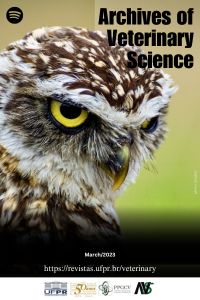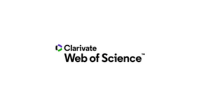Ultrasonography in the diagnosis of obesity in cats and its correlation with fructosamine and lipid levels
DOI:
https://doi.org/10.5380/avs.v1i1.88965Palavras-chave:
Diagnosis, subcutaneous fat, feline, hyperlipidemiaResumo
The aim of this study was to determine whether ultrasound imaging is an efficient method to assess subcutaneous fat in cats, the anatomical sites where more significant fat deposition occurs, and if there is a correlation between subcutaneous fat thickness and serum levels of cholesterol, triglycerides, and fructosamine. A total of 30 healthy adult cats were used and divided into three groups of 10 animals each, based on the estimated body condition score (BCS). The ideal group (IG) included cats with BCS 3; the overweight group (OWG), with BCS 4; and the obese group (OG), with BCS 5. Ultrasonographic measurement of subcutaneous fat was conducted in five anatomical regions: lumbar, abdominal, thoracic, femoral, and pectoral. We observed that obese cats had greater fat deposition in the abdominal and thoracic regions when compared to those with ideal weight, and that cholesterol and triglyceride levels were higher with the increase in subcutaneous fat thickness in the thoracic region. Nonetheless, there were no differences in fat deposition in the OWG compared to cats from the IG and OG. Ultrasonography made it possible to associate cholesterol and triglyceride levels with local fat deposits and to differentiate obese cats from those with ideal weight by analyzing the thickness of subcutaneous fat in the abdominal and thoracic regions, making this method efficient and less subjective.
Referências
Bartges J, Raditic D, Kirk C, et al. Nutritional Management of disease. In: Little S, eds. The Cat: Clinical Medicine and Management. 2º ed. St. Louis: Elsevier, 2012; 255-288. ISBN: 9781-4377-0660-4
Sparkes AH, Cannon M, Church D, et al. ISFM. ISFM consensus guidelines on the practical management of diabetes mellitus in cats. J Feline Med Surg, 17:(3); 235-250, 2015. Doi: 10.1177/1098612X15571880.
Chala, IV, Feshchenk DV, Oksana AD, et al. Changes in the lipid profile of neutered cats’ blood in cases of obesity and diabetes. Vet Arhiv, 91:(6);635-645, 2021. Doi: 10.24099/vet.arhiv.1087
Christopher J. H Simpson. Obesity. In: Norsworthy GD, Grace SF, Crystal MA, et al., eds. Feline Patient. 5th ed. St. Awenue: Wiley-Blackwell, 2018; 358-360. ISBN: 978-1-119-26903-8
Clark, M & Hoenig, M. Feline comorbidities: Pathophysiology and management of the obese diabetic cat. J Feline Med Surg, 23:(7);639-648, 2021. Doi: 10.1177/1098612X211021540
Cline, MG, Burns KM, Coe JB, et al. AAHA nutrition and weight management guidelines for dogs and cats. J Am Anim Hosp Assoc, 57:(4);153-178, 2021. Doi: 10.5326/JAAHA-MS-7232
Freitas VD, Castilho AR, Conceição LAV, et al. Metabolic evaluation in overweight and obese cats and association with blood pressure. Ciênc Rural, 48:(1);1-5, 2018. Doi: 10.1590/0103-8478cr20170217
Gates MC, Zito S, Harvey LC, et al. Assessing obesity in adult dogs and cats presenting for routine vaccination appointments in the North Island of New Zealand using electronic medical records data. N Z Vet J, 67;(3);126-133, 2019. Doi: 10.1080/00480169.2019.1585990
Hoenig M, Traas AM, Schaeffer DJ. Evaluation of routine hematology profile results and fructosamine, thyroxine, insulin, and proinsulin concentrations in lean, overweight, obese, and diabetic cats. J Am Vet Med Assoc, 243:(9);1302–1309, 2013. Doi: 10.2460/javma.243.9.1302
Iwazaki E, Hirai M, Tatsuta Y, et al. The relationship among ultrasound measurements, body fat ratio, and feline body mass index in aging cats. Jpn J Vet Res, 66(4);273-279, 2018. Doi: 10.14943/jjvr.66.4.273
Laflamme D. Development and Validation of a Body Condition Score System for Cats: A Clinical Tool. Feline Pract, 25:13-17, 1997. ISSN: 1057-6614
Link KR, Rand JS. Changes in blood glucose concentration are associated with relatively rapid changes in circulating fructosamine concentrations in cats. J Feline Med Surg, 10(6);583-592, 2008. Doi: 10.1016/j.jfms.2008.08.005
Mendes-Junior AF, Passos CB, Gáleas MAV, et al. Prevalência e fatores de risco da obesidade felina em Alegre-ES, Brasil. Semin Ciênc Agrár, 34:(4);1801-1806, 2013. Doi: 10.5433/1679-0359.2013v34n4p1801
Okada Y, Ueno H, Mizorogi T, et al. Diagnostic criteria for obesity disease in cats. Front Vet Sci, 6:284, 2019. Doi: 10.3389/fvets.2019.00284
Osto M, Lutz TA. Translational value of animal models of obesity - Focus on dogs and cats. Eur J Pharmacol, 759:240-252, 2015. Doi: 10.1016/j.ejphar.2015.03.036
Payan‑Carreira R, Martis L, Miranda S, et al. In vivo assessment of subcutaneous fat in dogs by real‑time ultrasonography and image analysis. Acta Vet Scand, 58:(1);11-18, 2016. Doi: 10.1186/s13028-016-0239-y
Santarossa A, Parr JM, Verbrugghe A. The importance of assessing body composition of dogs and cats and methods available for use in clinical practice. J Am Vet Med Assoc, 251:(5);521-529, 2017. Doi: 10.2460/javma.251.5.521
Simões DMN. Diabetes mellitus em gatos. In: Jericó MM, Andrade-Neto JP, Kogika MM, eds. Tratado de Medicina Interna de Cães e Gatos. Rio de Janeiro: Roca, 2015; 5220-5250. ISBN: 978-85-277-2666-5
Downloads
Publicado
Como Citar
Edição
Seção
Licença
Autores que publicam nesta revista concordam com os seguintes termos:
- Autores mantém os direitos autorais e concedem à revista o direito de primeira publicação, com o trabalho simultaneamente licenciado sob a Creative Commons - Atribuição 4.0 Internacional que permite o compartilhamento do trabalho com reconhecimento da autoria e publicação inicial nesta revista.
- Autores têm autorização para assumir contratos adicionais separadamente, para distribuição não-exclusiva da versão do trabalho publicada nesta revista (ex.: publicar em repositório institucional ou como capítulo de livro), com reconhecimento de autoria e publicação inicial nesta revista.
- Autores têm permissão e são estimulados a publicar e distribuir seu trabalho online (ex.: em repositórios institucionais ou na sua página pessoal) a qualquer ponto antes ou durante o processo editorial, já que isso pode gerar alterações produtivas, bem como aumentar o impacto e a citação do trabalho publicado.














